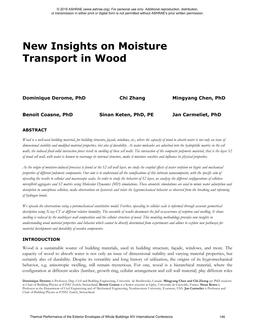
New Insights on Moisture Transport in Wood
Wood is a well-used building material, for building structure, façade, windows, etc., where the capacity of wood to absorb water is not only an issue ofdimensional stability and modified material properties, but also of durability. As water molecules are adsorbed into the hydrophilic matrix in the cellwalls, the induced fluid-solid interaction forces result in swelling of these cell walls. The interaction of the composite polymeric material, that is the layer S2of wood cell wall, with water is known to rearrange its internal structure, make it moisture sensitive and influence its physical properties.
As the origin of moisture-induced processes is found at the S2 cell wall layer, we study the coupled effects of water sorption on hygric and mechanicalproperties of different polymeric components. Our aim is to understand all the ramifications of this intricate nanocomposite, with the specific aim ofupscaling the results to cellular and macroscopic scales. In order to study the behavior of S2 layer, we analyze the different configurations of cellulosemicrofibril aggregates and S2 matrix using Molecular Dynamics (MD) simulations. These atomistic simulations are used to mimic water adsorption anddesorption in amorphous cellulose, make observations on hysteresis and relate the hygromechanical behavior as observed from the breaking and reformingof hydrogen bonds.
Product Details
- Published:
- 2019
- Number of Pages:
- 8
- Units of Measure:
- Dual
- File Size:
- 1 file , 5 MB
- Product Code(s):
- D-Bldgs19-016


